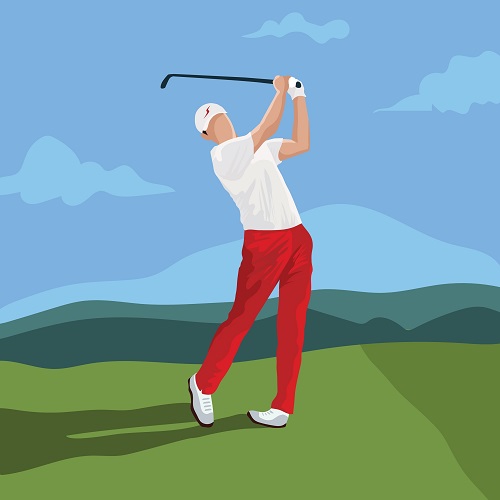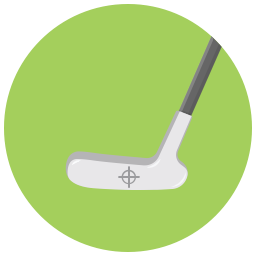How to Hit Long Irons
When tackling the question on how to hit long irons, players must realize the answer lies within themself.
Since the long iron has a longer shaft, it can be difficult to hit long irons purely with regularity.
Even when amateur golfers use the old standby instruction of shoulder width stance with a full turn, the club can still become locked.
This creates a steep attack angle on the golf ball, resulting in a thin shot that causes groans and cringes among playing partners.
In this article, we’ll break down each long iron, from the 3-irons to the utility irons, and offer a few drills that you can immediately take to the practice range to improve your long iron shots.

What You Will Learn In This Post
CHAPTER 1
How to Hit The 3-Iron
The 3-iron carries a loft around 21 degrees on the club face, producing a low flight, similar to a utility iron.
Great for punch shots, 3-irons, and higher lofted clubs like the 5-iron, must be used delicately to avoid thin shots.
Finding the Right Low Point
The biggest thing with hitting a long iron correctly is striking the ball cleanly.
While swinging the golf club on the proper plane is essential, if you hit behind the ball, then the pretty arc means nothing. The same general rule holds true with a short iron.
For the 3-iron, you still happen to need to place the golf ball forward in your stance, but a bit more center-located than for an utility iron.
A great tip for hitting the ball at the low point in the swing is getting the lead shoulder directly over the lead ankle at impact.
Swinging the 3-iron Like a Hybrid
An alternative way to evaluate the 3-iron is by taking a look at the difference between long irons vs hybrids.
While hybrids offer an easier shot process, the 3-iron offers more control, even if you play the club with a sweeping attack angle to help lift on the shot.
Hitting the 3-iron Long
While the club shaft length does most of the distance work, players can add a few extra yards with a couple of tweaks.
By taking the right foot and left foot and flaring it out, with the toes pointing at a 45-degree angle, players can hit the ball high.
CHAPTER 2
How to Hit the 4-Iron
Although the club is considered to be a tweener with long irons, the 4-iron uses a slightly forward ball position to elevate each long iron shot. The secret to hitting long irons crisply remains in controlling the body.
When answering the question of how to hit long irons with success, the same thing holds true for any shot.
Without tempo and forward movement into the golf ball, long iron shots won’t have the power needed to reach the expected distance.
Play Aggressive With Long Irons
Another pitfall that serious players fall into is when hitting long irons with timidness.
Unlike their approach with short irons, most weekend warriors treat their long irons with kid gloves, meaning they act as if they don’t want to break them while executing their downswing.
But to make it to the next level, it remains incredibly vital for players to move aggressively through the ball to let the club manufacture the ideal results.
Keeping Your Head Still During the Downswing
One of the worst things that players can do with long irons, like 4-irons, is to introduce unnecessary movement into the swing.
By keeping the head still, the golfer’s frame can freely rotate through the ball with staggering speed.
The catch to this rule is to move the head naturally with the secondary shoulder to complete the follow-through. In the end, you simply want to avoid adding more resistance to the swing before impact.
CHAPTER 3
How to Hit the 5-Iron
With the 5-iron, players can utilize the loft to hit the golf ball high resulting in a relatively soft iron shot that creates similar spin rates with short irons and a pitching wedge.
A long iron shot can still be accomplished with the 5-iron, especially in moderate distance situations, say around 200 yards.
Golf instruction teachers routinely suggest ball position with the 5-iron can be played more toward the center of the stance, especially if you are using the club on punch shots.
Use Your Body to Generate Power
Hitting long irons can be a tricky proposition, but with the proper golf swing mechanics, players can use their stance, head position, club length to power the golf ball to the green with more regularity during the round.
The lower body, especially the legs and hips, can quickly generate the swing speed needed to hit long irons with consistency.
Hit the 5-Irons Like a Short Irons
One of the biggest mistakes that amateurs make with their 5-iron is playing the ball far too forward in their stance.
This ball position causes problems with compressing the ball at impact, creating thin contact with your longer irons.
Moving the ball closer to the center position, just inside the front thigh, is a great starting position to play with your 5-iron, just like you would with a short iron.
By swinging with a tight rotation, even if you are hitting long irons off the tee, you’ll hit long with the same feel and response of shorter irons.
CHAPTER 4
How to Hit the Utility Iron
Most amateurs have the skill set to hit crisp, impressive long irons from the tee and fairway, but for those that fail to execute, all they need is a great plan of attack.
This rule is especially true with the hardest long iron to hit: the utility iron.
Offering the loft of a fairway wood, the utility wood has grown in popularity among advanced players, especially those on the PGA Tour.
With lofts from 17 to 25 degrees, the utility iron works off the tee box and from the fairway.
Ball Higher in Stance
One of the biggest things with hitting a utility iron is getting the ball further forward in the stance. Most advanced golfers place the ball just inside the front heel, more toward the front center.
Longer irons, such as the utility iron, utilize the shallow loft to drive the ball with a low, penetrating flight that offers distance that could be slightly longer than playing hybrids in the same situation.
Don’t Bend the Wrists
On the backswing, players need to keep the shoulders, clubs and grip as one connected unit.
To hit the ball with the correct attack angle, you want a compact swing, where the club does not reach parallel, with a strong follow-through.
By breaking the wrists, the average golfer introduces inconsistency into their backswing.
Holding the Follow Through
After impact, the average golfer needs to finish their downswing with the center of their chest pointing directly to the target.
Most golfers use the belly button to connect to the flag, others use their head, even their nose, to lock into the green.
CHAPTER 5
Best Drills for Hitting Long Irons
When it comes time to take the instruction to the practice range, the best way to focus your time is by implementing your new strategy through repetition created by a long iron drill.
While the early stages of changing your swing can be incredibly frustrating, successful players must take their time in building a routine that creates consistent contact for the long irons in their bag.
Here are three drills that you can immediately take to the range before your round to help you dial in those long irons.
Drill 1: The Floatie
For this drill, you’ll need one swimming floatie that goes over the bicep to help keep you afloat while wading in water.
The point of this drill is to shorten the backswing to promote a compact takeaway with the forward body motion needed for hitting a crisp ball.
If you are a right-handed golfer, take the floatie and put it on your arm, centering the device on your back arm elbow.
For right handers, it will be the right elbow. For left-handed golfers, it will be the left.
Taking your normal stance, begin your backswing and feel the floatie restricting the back arm from bending.
After feeling this sensation a few times, make a full swing with a turn, getting the front shoulder under the chin. If you are videoing your workout, you will notice that the backswing is much shorter and compact.
When it comes time to hit the ball, start with 50% swings, with a takeaway that stops at your shoulder. After 10-15 half-swings, move to full swings keeping the backswing short and compact.
Drill 2: The Towel
One of the biggest mistakes that amateur players make when hitting long irons is stopping the shoulders when they hit the ball and, instead, letting the arms take over rather than making a full follow-through.
To correct this, we utilize this drill to keep the upper body working as one unit.
With a golf towel centered in the middle under your chest, directly under your arms, you can create a powerful drill for creating solid contact with your long iron play.
The towel helps players stay connected to the club throughout the swing.
When you begin, take small half to three-quarter swings with an emphasis on finishing the swing. At the conclusion, you want the middle of the chest to be facing the target.
After you remove the towel, work on keeping your arms inside the swing with the same tempo used with the towel on your full swings.
Conclusion
By focusing on each iron during practice, and utilizing the drills we’ve laid out in our last section, you’ll find that the quality of your contact with each long iron in your golf bag will greatly improve.
Whether you use the local driving range or work on your game in your backyard, spending time learning to make quality contact with each long iron can only improve the distance and accuracy of your long iron game.
On long par 3s and from the fairway, a well-placed 5-iron can save a score, helping the average golfer of any skill level exact their precision with long irons to produce wonderful results.
While hitting long irons is not easy, even for the most advanced golfers, realizing that practice and repetition, using the right fundamental approach, is the only way to improve.



